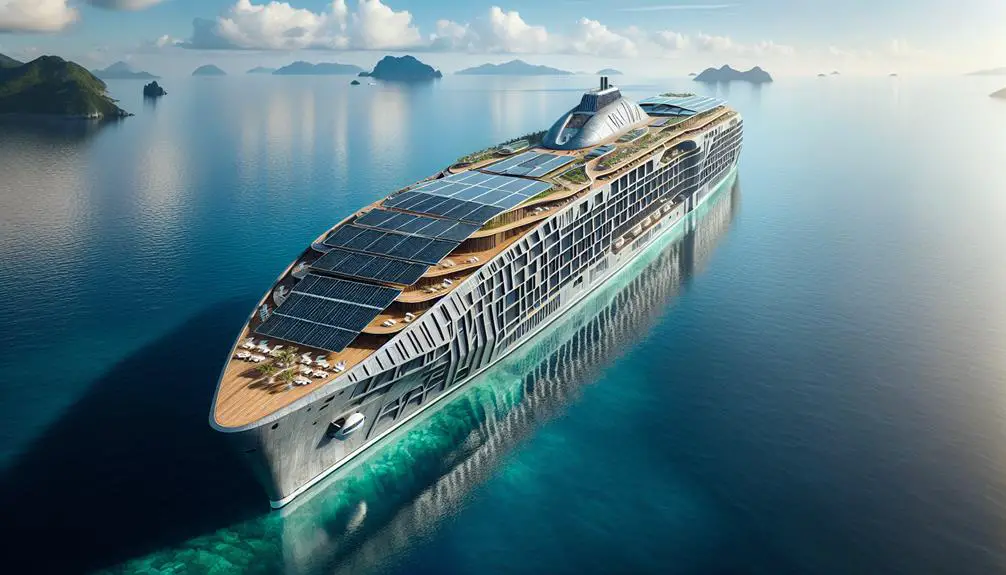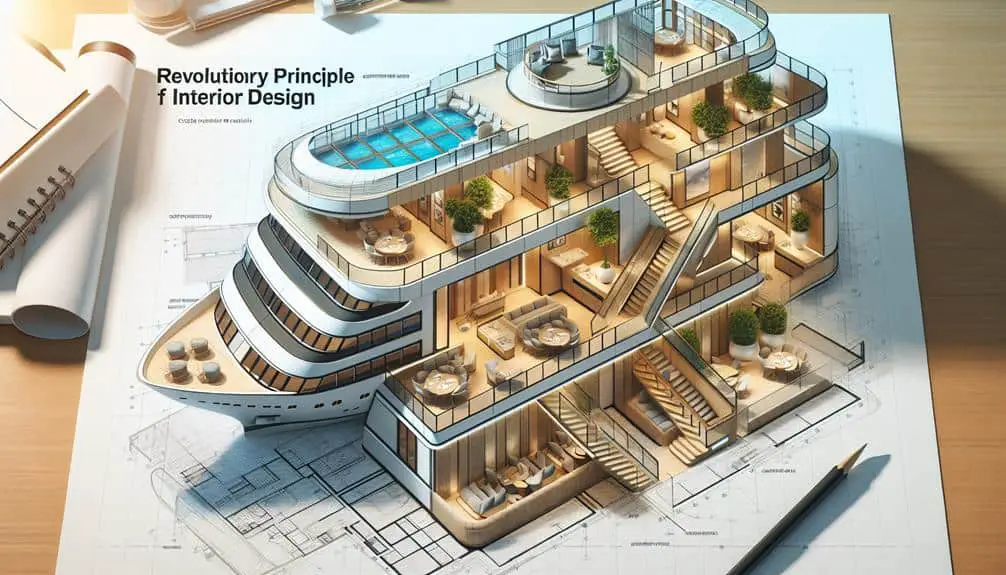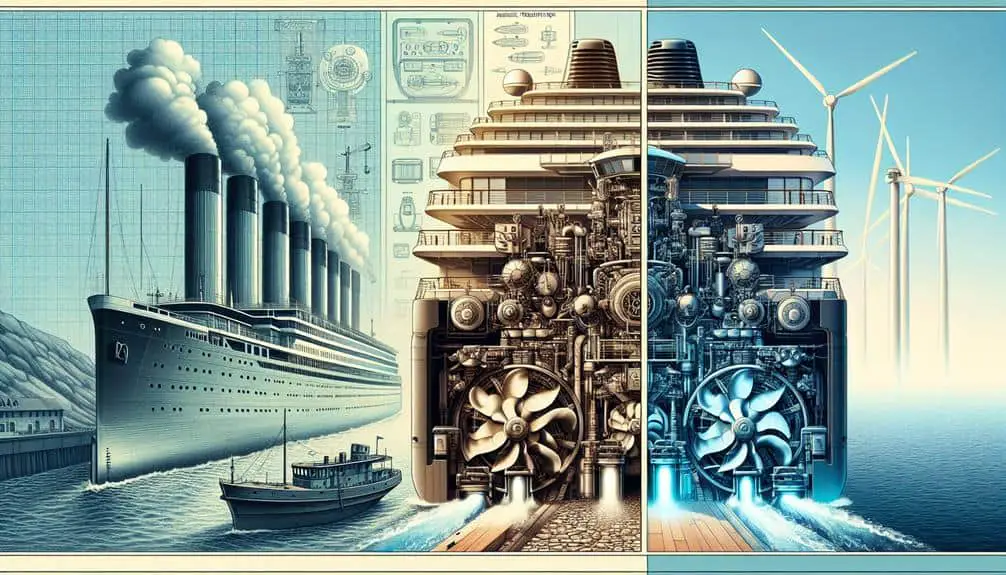Discover cutting-edge trends in sustainable cruise ship design such as advanced composite materials for durability. Biodegradable insulation guarantees proper thermal control, while solar-powered lighting systems reduce energy consumption. Opt for eco-friendly bio-based paints for aesthetics and minimal emissions. Embrace energy-efficient propulsion like solar engines and hydrogen fuel cells for reduced emissions. Implement smart waste management strategies like recycling and composting. Maximize space utilization with modular layouts, ergonomic furnishings, and multifunctional furniture. Enhance passenger comfort with biophilic interiors, incorporating natural elements for better air quality. Explore these innovations shaping the future of eco-friendly marine travel.
Key Points
- Advanced composite materials for sustainability.
- Solar powered engines for reduced emissions.
- Waste reduction strategies for eco-friendly practices.
- Modular layouts for optimal space utilization.
- Biophilic interiors enhancing passenger comfort.
Eco-Friendly Materials and Technologies
Utilizing advanced composite materials and energy-efficient technologies is paramount in modern sustainable cruise ship design. Biodegradable insulation plays an essential role in reducing environmental impact while ensuring ideal thermal regulation within the vessel.
Solar powered lighting systems offer an eco-friendly alternative, harnessing renewable energy to illuminate various areas of the ship.
Recycled flooring materials, derived from post-consumer products, provide both durability and sustainability, contributing to the overall eco-conscious design.
Additionally, the integration of bio-based paints not only enhances the aesthetic appeal of the cruise ship but also minimizes the release of harmful volatile organic compounds into the environment.
These eco-friendly materials and technologies not only align with sustainable practices but also cater to the growing demand for responsible tourism. By incorporating biodegradable insulation, solar powered lighting, recycled flooring, and bio-based paints, cruise ships can notably reduce their carbon footprint and set a new standard for environmentally conscious maritime travel.
Energy-Efficient Propulsion Systems
Enhancing cruise ship sustainability, energy-efficient propulsion systems play an essential role in reducing fuel consumption and environmental impact. Two key technologies leading the way in this field are solar powered engines and hydrogen fuel cells.
Solar powered engines harness the energy from sunlight through photovoltaic panels to generate electricity that powers the ship's propulsion system. These engines utilize renewable energy, reducing the reliance on traditional fuel sources and lowering greenhouse gas emissions. By converting sunlight into electricity, solar powered engines provide a clean and sustainable propulsion solution for cruise ships.
Hydrogen fuel cells are another innovative propulsion system that produces electricity by combining hydrogen and oxygen, with water vapor as the only byproduct. This emission-free technology offers high efficiency and quiet operation, making it an attractive option for sustainable cruise ship design. By integrating hydrogen fuel cells into propulsion systems, cruise ships can significantly reduce their environmental footprint while ensuring a smooth and eco-friendly sailing experience.
Sustainable Waste Management Solutions
Solar powered engines and hydrogen fuel cells are pivotal in reducing fuel consumption and environmental impact on cruise ships. When it comes to sustainable waste management solutions, efficient practices are essential for maintaining a clean and eco-friendly ship environment. Waste reduction strategies play a critical role in minimizing the amount of waste generated onboard.
Implementing recycling innovations allows for the reuse of materials, reducing the need for virgin resources and cutting down on waste disposal.
In addition to waste reduction, sustainable waste disposal methods are imperative. Cruise ships can incorporate composting solutions to manage organic waste efficiently. Composting not only reduces the volume of waste sent to landfills but also produces nutrient-rich soil that can be used in onboard gardening or donated at port stops.
Smart Design for Space Optimization
Efficient spatial planning is essential for maximizing onboard functionality and passenger comfort in sustainable cruise ship design. To achieve this, cruise ships are increasingly utilizing modular layouts and ergonomic furnishings.
Modular layouts involve dividing spaces into functional units that can be easily reconfigured to adapt to different needs. This allows for flexible use of spaces, optimizing their utilization and enhancing passenger experience.
Ergonomic furnishings play a pivotal role in space optimization by ensuring that furniture isn't only comfortable but also designed to fit the space efficiently. For instance, multifunctional furniture pieces like sofa beds or tables with storage compartments help maximize space utilization without compromising on comfort. Additionally, ergonomic design principles are applied to various elements onboard, such as seating arrangements in dining areas or workstations in public spaces.
Green Initiatives for Passenger Comfort
How can sustainable cruise ship designs incorporate green initiatives to enhance passenger comfort while minimizing environmental impact?
One way is through the implementation of biophilic interiors, which involve integrating natural elements like plants, water features, and natural light into the ship's design. These biophilic elements can improve air quality, reduce stress, and create a connection to the natural world, enhancing the overall comfort and well-being of passengers.
Additionally, essential energy sources play an important role in sustainable cruise ship designs geared towards passenger comfort. Utilizing solar panels, wind turbines, and biofuel systems can help reduce the ship's carbon footprint while providing clean energy to power amenities such as air conditioning, lighting, and entertainment systems.
Frequently Asked Questions
How Do Cruise Ship Designers Prioritize Passenger Safety While Incorporating Sustainable Design Features?
To prioritize passenger safety while incorporating sustainable design features, cruise ship designers guarantee robust emergency protocols, advanced surveillance systems, and structural integrity. By integrating energy-efficient technologies and optimizing passenger comfort, vessels achieve a harmonious balance between safety and sustainability.
What Measures Are Being Taken to Reduce the Environmental Impact of Cruise Ship Construction and Maintenance Processes?
To reduce the environmental impact of cruise ship construction and maintenance processes, energy-efficient materials are utilized. Sustainable propulsion systems decrease emissions. Green shipyards implement eco-friendly coatings, minimizing harmful substances released into the ocean, ensuring a more sustainable approach to shipbuilding.
Are There Any Innovative Technologies Being Developed to Reduce Noise Pollution From Cruise Ship Operations?
When it comes to reducing noise pollution from cruise ship operations, incorporating innovative technologies is key. An interesting statistic reveals that underwater noise can travel up to 10 kilometers, emphasizing the importance of effective mitigation strategies.
How Do Cruise Lines Ensure Compliance With International Environmental Regulations and Standards in Their Sustainable Design Practices?
To guarantee compliance with international environmental regulations and standards in sustainable design, cruise lines implement energy-efficient systems, advanced waste management practices, water conservation initiatives, and integrate green technologies like solar panels and LED lighting to minimize environmental impact.
What Sustainable Practices Are Being Implemented in the Operation and Maintenance of Cruise Ship Facilities, Beyond the Initial Design Phase?
You enhance sustainability in cruise ship operations by optimizing energy efficiency through advanced propulsion systems and LED lighting. Effective waste management involves recycling programs and wastewater treatment plants. These practices guarantee eco-friendly cruise experiences.




